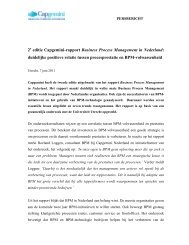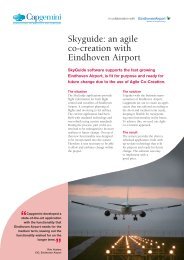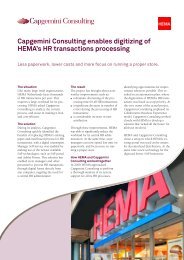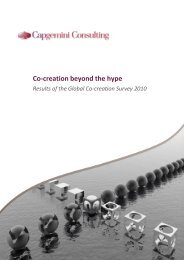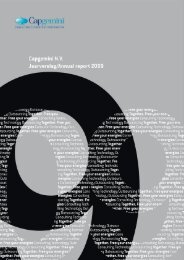IT transformations - Capgemini Consulting Nederland
IT transformations - Capgemini Consulting Nederland
IT transformations - Capgemini Consulting Nederland
You also want an ePaper? Increase the reach of your titles
YUMPU automatically turns print PDFs into web optimized ePapers that Google loves.
Portable Connected Devices and the Content Opportunity<br />
One of the biggest developments in the past year has been the advent and rapid rise in popularity of portable connected devices such as the Apple<br />
iPad. While tablet PCs have been around since 2000 very few have been able to create the compelling user experience that Apple has done through<br />
its iPad. The results are telling. In 2010, Apple sold over 15 million iPads in the 9 months that it was available in the market and has already released<br />
the iPad 2 with enhanced features a . It is now estimated that global tablet shipments are set for a 12-fold rise from 19.7 million units in 2010 to over<br />
242.3 million units by 2015 b . Devices such as the iPad encourage increased consumption of various types of content in both nomadic and mobile<br />
environments, giving rise to more monetization opportunities. Through their highly interactive and immersive design, these devices allow content<br />
owners to reach out to consumers in ways that were traditionally not possible.<br />
Figure: Survey Response to Category of Content Regularly Accessed, Global, August 2010<br />
53%<br />
51%<br />
39%<br />
33%<br />
32%<br />
25%<br />
21% 22% 44%<br />
41%<br />
13%<br />
11%<br />
12%<br />
8%<br />
Books TV Shows Movies Magazines Radio News Music<br />
iPad<br />
iPhone<br />
Source: Nielsen, The Increasingly Connected Consumer: Connected Devices, October 2010<br />
The larger 9.7” sized screen of the iPad with a large on-screen keyboard, allows for convenient viewing of a range of content category, with<br />
traditional print and video being the most favored (see Figure above). Content owners have begun to recognize the premium nature of the<br />
device — prices starting at US$499 going up to US$829 for the top-end model — and have taken early steps to tap into the potential of the iPad<br />
demographic.<br />
For publishers, devices such as the iPad offer a clear route to creating price plans that merit the medium, rather than relying on having a single<br />
serve-all website-driven solution. Publishers such as Conde Nast have realized this and have introduced apps that are priced similar to their print<br />
equivalents. Conde Nast’s Wired iPad app sold over 95,000 units at US$4.99 in June 2010 (a price that has continued to the time of publishing). A<br />
lot of the content of Wired magazine is already available for free on their site or at deeply discounted yearly subscriptions of US$10 c . These apps<br />
offer rich content including videos, annotations, expanded photo galleries, and interactive advertisements that can potentially help drive engagement<br />
levels. Publishers are experimenting with models where each issue is a separate app or they are using a common container app with in-app<br />
purchases for new issues. Other magazines such as Time and The Atlantic are also experimenting with similar pricing approaches. Content players<br />
are also launching free apps that they are seeking to monetize using mobile advertising. Research commissioned by a consortium of five leading<br />
publishers indicated that the publishing industry could gain as much as US$1.3 billion in incremental revenues through interactive periodicals d .<br />
Newspaper publishers too are viewing the medium with expectation and anticipation. News Corp invested over US$30 million to launch “The Daily”,<br />
an iPad-only newspaper that is priced at $0.99 per week or $39.99 annually e . Video aggregators and broadcasters are among the latest entrants<br />
to this opportunity. The BBC is reported to be working on launching a subscription-based offering of its popular iPlayer service on the iPad for<br />
audiences outside the UK f . Similarly, video streaming services such as Hulu and Netflix have launched dedicated apps for the iPad.<br />
These are early days for the device category. As such, the current traction could likely be attributed to the initial enthusiasm for the format. Moreover,<br />
the market is growing rapidly and Apple now faces strong competition from a variety of vendors that are using the Google Android platform and from<br />
other players such as RIM. However, the initial wave of applications and the traction generated indicate the strong potential of the medium. Content<br />
players should keep an active eye on this rapidly evolving category and its likely impact on the overall content ecosystem.<br />
a) Company website.<br />
b) iSuppli, Global Tablet Shipments to Rise by Factor of 12 by 2015, February 2011.<br />
c) All Things Digital, Wired’s iPad App Boasts a New Feature: A Price Cut, June 2010.<br />
d) Media post, Subscription Revenue Boost With Interactive Periodicals, August 2010.<br />
e) Fast Company, Apple and News Corp’s “The Daily” Hits the iPad for $0.99 Weekly, $40 Yearly, February 2011.<br />
f) Paid Content, BBC Plans Subscription-Only U.S. iPlayer on iPad, December 2010.<br />
73



